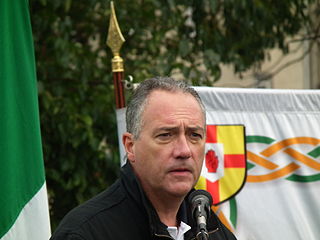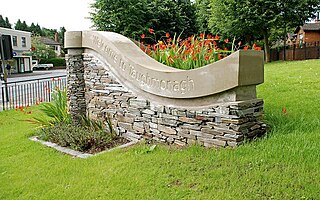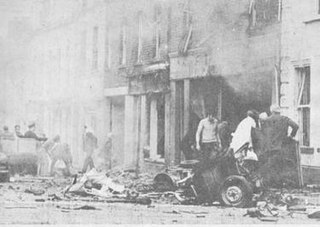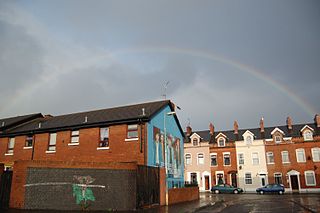Bloody Friday is the name given to the bombings by the Provisional Irish Republican Army (IRA) in Belfast, Northern Ireland on 21 July 1972, during the Troubles. At least twenty bombs exploded in the space of eighty minutes, most within a half-hour period. Most of them were car bombs and most targeted infrastructure, especially the transport network. Nine people were killed: five civilians, two British soldiers, a Royal Ulster Constabulary (RUC) reservist, and an Ulster Defence Association (UDA) member, while 130 were injured. The IRA said it sent telephoned warnings at least thirty minutes before each explosion and said that the security forces wilfully ignored some of the warnings for their own ends. The security forces said that was not the case and said they were overstretched by the sheer number of bombs and bomb warnings, some of which were hoaxes.

Elizabeth Williams was a peace activist from Northern Ireland. She was a co-recipient with Mairead Corrigan of the Nobel Peace Prize in 1976 for her work as a cofounder of Community of Peace People, an organisation dedicated to promoting a peaceful resolution to the Troubles in Northern Ireland.

Mairead Maguire, also known as Mairead Corrigan Maguire and formerly as Mairéad Corrigan, is a peace activist from Northern Ireland. She co-founded, with Betty Williams and Ciaran McKeown, the Women for Peace, which later became the Community for Peace People, an organization dedicated to encouraging a peaceful resolution of the Troubles in Northern Ireland. Maguire and Williams were awarded the 1976 Nobel Peace Prize.

William Moore, was a Northern Irish loyalist. He was a member of the Shankill Butchers, an Ulster Volunteer Force (UVF) gang. It was Moore who provided the black taxi and butcher knives which the gang used to carry out its killings. Following ringleader Lenny Murphy's arrest, Moore took over as the de facto leader of the gang and the killings continued.

Séanna Walsh or Séanna Breathnach is a Sinn Féin member of Belfast City Council and a former volunteer in the Provisional Irish Republican Army (IRA).

On 19 March 1988, the British Army corporals Derek Wood and David Howes were killed by the Provisional IRA in Belfast, Northern Ireland, in what became known as the corporals killings.

Mairéad Farrell was a member of the Provisional Irish Republican Army (IRA). She was shot and killed by the British Army in Gibraltar on 6 March 1988.
This is a chronology of activities by the Provisional Irish Republican Army (IRA) from 1970 to 1979.

Andersonstown, known colloquially as Andytown, is a suburb of west Belfast, Northern Ireland, at the foot of the Black Mountain and Divis Mountain. It contains a mixture of public and private housing and is largely a working-class area with a strong Irish nationalist and Irish Catholic tradition. The district is sometimes colloquially referred to as "Andytown". This area stretches between the Shaws Road, the Glen Road and the Andersonstown Road.

The Falls Curfew, also called the Battle of the Falls, was a British Army operation during 3–5 July 1970 in the Falls district of Belfast, Northern Ireland. The operation began as a search for weapons in the staunchly Irish nationalist district. As the search ended, local youths attacked the British soldiers with stones and petrol bombs and the soldiers responded with CS gas. This quickly developed into gun battles between British soldiers and the Irish Republican Army (IRA). After four hours of continuous clashes, the British commander sealed off the area, which comprised 3,000 homes, and imposed a curfew which would last for 36 hours. Thousands of British troops moved into the curfew zone and carried out house-to-house searches for weapons, while coming under intermittent attack from the IRA and rioters. The searches caused much destruction, and a large amount of CS gas was fired into the area. Many residents complained of suffering abuse at the hands of the soldiers. On 5 July, the curfew was brought to an end when thousands of women and children from Andersonstown marched into the curfew zone with food and other supplies for the locals.
The Dunmurry train bombing was a premature detonation of a Provisional Irish Republican Army (IRA) incendiary bomb aboard a Ballymena to Belfast passenger train service on 17 January 1980.

The Belfast Brigade of the Provisional IRA was the largest of the organisation's brigades, based in the city of Belfast, Northern Ireland.

Taughmonagh is a small housing estate in south west Belfast, Northern Ireland, within the civil parishes of Drumbeg and Shankill, and barony of Belfast Upper. Taughmonagh has become known for being a staunchly loyalist estate.
This is a timeline of actions by the Irish National Liberation Army (INLA), an Irish republican socialist paramilitary group. Most of these actions took place as part of its 1975–1998 campaign during "the Troubles" in Northern Ireland. The INLA did not start claiming responsibility for its actions under the INLA name until January 1976 at which point they had already killed 12 people, before then they used the names People's Liberation Army (PLA) and People's Republican Army (PRA) to claim its attacks.
This is a chronology of activities by the Provisional Irish Republican Army (IRA) from 1980 to 1989. For actions before and after this period see Chronology of Provisional Irish Republican Army actions.

From 6 to 11 July 1997 there were mass protests, fierce riots and gun battles in Irish nationalist districts of Northern Ireland. Irish nationalists/republicans, in some cases supported by the Provisional Irish Republican Army (IRA), attacked the Royal Ulster Constabulary (RUC) and British Army. The protests and violence were sparked by the decision to allow the Orange Order to march through a Catholic/nationalist neighbourhood of Portadown. Irish nationalists were outraged by the decision and by the RUC's aggressive treatment of those protesting against the march. There had been a bitter dispute over the march for many years.

On 12 June 1973 the Provisional IRA detonated two carbombs in Coleraine, County Londonderry, Northern Ireland. The first bomb exploded at 3:00 pm on Railway Road, killing six people and injuring 33; several lost limbs and were left disabled for life. A second bomb exploded five minutes later at Hanover Place. This did not cause any injuries, although it added to the panic and confusion in the area. The IRA had sent a warning for the second bomb but said it had mistakenly given the wrong location for the first.

In the late hours of 3 February and the early hours of 4 February 1973, six men, all of whom were Catholics, were shot and killed in the New Lodge area of north Belfast:
This is a timeline of actions by the Official Irish Republican Army, an Irish republican & Marxist-Leninist paramilitary group. Most of these actions took place as part of a Guerrilla campaign against the British Army & Royal Ulster Constabulary and internal Irish Republican feuds with the Provisional IRA & Irish National Liberation Army from the early 1970s - to the mid-1970s during the most violent phase of "the Troubles" in Northern Ireland.
The Stag Inn attack was a sectarian gun attack, on 30 July 1976, carried out by a group of Belfast IRA Volunteers using the cover name Republican Action Force. Four Protestants, all civilians, the youngest being 48 years old and the eldest 70, were all killed in the attack with several others being injured. Three Catholics were killed the previous day in a Loyalish bomb, part of a string of sectarian attacks in Northern Ireland by different paramilitary organizations.












